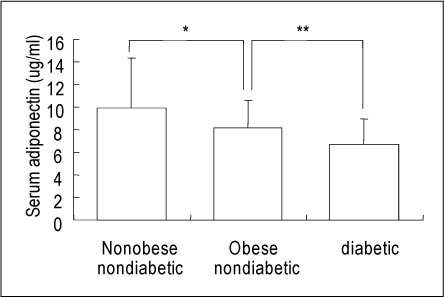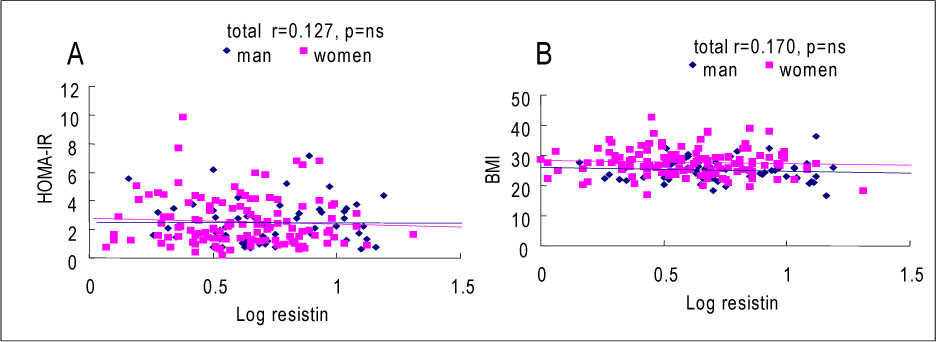J Korean Soc Endocrinol.
2005 Oct;20(5):444-451. 10.3803/jkes.2005.20.5.444.
The Relation of Serum Adiponectin and Resistin Concentrations with Metabolic Risk Factors
- Affiliations
-
- 1Division of Endocrinology, Department of Internal Medicine, Gwangmyung Sung-Ae Hospital, Korea.
- KMID: 2200591
- DOI: http://doi.org/10.3803/jkes.2005.20.5.444
Abstract
-
BACKGROUND: Adiponectin is a fat cell-secreted cytokine, which has been reported to improve insulin sensitivity and have antiatherogenic properties. However, it is still unclear whether resistin plays a significant role in the development of insulin resistance in humans. The aim of this study was to investigate the relationship of the adiponectin and resistin concentrations with insulin resistance, metabolic markers and adiposity in healthy and type 2 diabetic subjects.
METHODS
Eighty-three type 2 diabetic and 139 healthy subjects were studied. Blood samples were drawn after fasting to determine the fasting plasma glucose, insulin, resistin, adiponectin, total cholesterol, triglyceride and HDL-cholesterol levels. The subcutaneous and visceral fat areas were measured at the umbilical level using computed tomography.
RESULTS
The serum adiponectin concentrations were significantly lower in the diabetic(6.7+/-2.3microgram/mL) than in the obese(8.2+/-2.4microgram/mL, P<0.01) and non-obese subjects(9.9+/-4.5microgram/mL, P<0.01). The serum resistin concentrations were Similar between the non-obese, obese and type 2 diabetic subjects. From a multiple regression analysis, the fasting glucose, HDL-cholesterol and HOMA-IR were found to be independent determinants of the log of the adiponectin level in the diabetes group. In healthy subjects, the gender, BMI, HOMA-IR, visceral fat area and HDL-cholesterol were associated with the log of the adiponectin level. However, the log of the resistin level was not associated with the markers of insulin resistance and obesity.
CONCLUSION
This study showed that the serum adiponectin concentration was closely related to the insulin resistance marker in both healthy and type 2 diabetic subjects. However, the resistin concentration was not associated with the markers of insulin resistance and/or obesity.
MeSH Terms
Figure
Cited by 2 articles
-
The Effects of D-Chiro-Inositol on Glucose Metabolism in 3T3-L1 Cells
Kang Seo Park, Jae Min Lee, Bon Jeong Ku, Young Suk Jo, Seong Kyu Lee, Kyung Wan Min, Kyung Ah Han, Hyo Jeong Kim, Hyun Jin Kim
Korean Diabetes J. 2008;32(3):196-203. doi: 10.4093/kdj.2008.32.3.196.The Effects of 12-Weeks Intensive Intervention Program on Cardiovascular Risk Factors, Adipocytokines and Nutrients Intakes in Industrial Male Workers
Kieun Moon, Ill Keun Park, Yeon Sang Jo, Yun Kyun Chang, Yun Mi Paek, Tae In Choi
Korean J Nutr. 2011;44(4):292-302. doi: 10.4163/kjn.2011.44.4.292.
Reference
-
1. Tsao TS, Lodish HF, Freubis J. ACRP30, a new hormone controlling fat and glucose metabolism. Eur J Pharmacol. 2002. 440:213–221.2. Weyer C, Funahashi T, Tanaka S, Hotta K, Matsuzawa Y, Pratley RE, Tataranni PA. Hypoadiponectinemia in obesity and type 2 diabetes: close association with insulin resistance and hyperinsulinemia. J Clin endocrinol Metab. 2001. 86:1930–1935.3. Cnop M, Havel PJ, Utzschneider KM, Carr DB, Sinha MK, Boyko EJ, Retzlaff BM, Knopp RH, Brunzell JD, Kahn SE. Relationship of adiponectin to body fat distribution, insulin sensitivity and plasma lipoproteins: evidence for independent roles of age and sex. Diabetologia. 2003. 46:459–469.4. Hotta K, Funahashi T, Arita Y, Takahashi M, Matsuda M, Okamoto Y, Iwahashi H, Kuriyama H, Ouchi N, Maeda K, Nishida M, Kihara S, Sakai N, Nakajima T, Hasegawa K, Muraguchi M, Ohmoto Y, Nakamura T, Yamashita S, Hanafusa T, Matsuzawa Y. Plasma concentrations of a novel, adipose-specific protein, adiponectin, in type 2 diabetic patients. Arterioscler Thromb Vasc Biol. 2000. 20:1595–1599.5. Mallamaci F, Zoccali C, Cuzzola F, Tripepi G, Cutrupi S, Parlongo S, Tanaka S, Ouchi N, Kihara S, Funahashi T, Matsuzawa Y. Adiponectin in essential hypertension. J Nephrol. 2002. 15:507–511.6. Kumada M, Kihara S, Sumitsuji S, Kawamoto T, Matsumoto S, Ouchi N, Arita Y, Okamoto Y, Shimomura I, Hiraoka H, Nakamura T, Funahashi T, Matsuzawa Y. Osaka CAD Study Group. Coronary artery disease: Association of hypoadiponectinemia with coronary artery disease in men. Arterioscler Thromb Vasc Biol. 2003. 23:85–89.7. Steppan CM, Bailey ST, Bhat S, Brown EJ, Banerjee RR, Wright CM, Patel HR, Ahima RS, Lazar MA. The hormone resistin link obesity to diabetes. Nature. 2001. 409:307–312.8. Mcternan CL, Mcternan PG, Harte AL, Levick PL, Barnett AH, Kumar S. Resistin, central obesity, and type 2 diabetes. Lancet. 2002. 259:46–47.9. Kim KH, Lee K, Moon YS, Sul HS. A cystein-rich adipose tissue-specific secretory factors inhibits adipocyte differentiation. J Biol Chem. 2001. 276:11252–11256.10. Way JM, Gorgun CZ, Tong Q, Uysal KT, Brown KK, Harrington WW, Oliver JR, Wilson TM, Kliewer SA, Hotamisligil GS. Adipose tissue resistin expression is severly suppressed in obesity and stimulated by peroxisome proliferators-activated receptor α agonists. J Biol Chem. 2001. 276:25651–25653.11. Savage DB, Sewter CP, Klenk ES, Segal DG, Vidal-Puig A, Considine RV, Orahilly S. Resistin/Fizz3 expression in relation to obesity and peroxisome proliferator-activated receptor- an action in human. Diabetes. 2001. 50:2199–2202.12. Ahima RS, Flier JS. Adipose tissue as an endocrine organ. Trends Endocrinol Metab. 2000. 11:327–332.13. Maeda N, Takahashi M, Funahashi T, Kihara S, Nishizawa H, Kishida K, Nagaretani H, Matsuda M, Komuro R, Ouchi N, Kuriyama H, Hotta K, Nakamura T, Shimomura I, Matsuzawa Y. PPARgamma ligands increase expression and plasma concentrations of adiponectin, an adipose-derived protein. Diabetes. 2001. 50:2094–2099.14. Phillips SA, Ciaraldi TP, Kong AP, Bandukwala R, Aroda V, Carter L, Baxi S, Mudaliar SR, Henry RR. Modulation of circulating and adipose tissue adiponectin levels by antidiabetic therapy. Diabetes. 2003. 52:667–674.15. Combs TP, Wagner JA, Berger J, Doebber T, Wang WJ, Zhang BB, Tanen M, Berg AH, O'Rahilly S, Savage DB, Chatterjee K, Weiss S, Larson PJ, Gottesdiener KM, Gertz BJ, Charron MJ, Scherer PE, Moller DE. Induction of adipocyte complement-related protein of 30kilodaltons by PPARgamma agonists: a potential mechanism of insulin sensitization. Endocrionology. 2002. 143:998–1007.16. Berg AH, Combs TP, Du X, Brownlee M, Scherer PE. The adipocyte-secreted protein Acrp30 enhances hepatic insulin action. Nat Med. 2001. 7:947–953.17. Fruebis J, Tsao TS, Javorschi S, Ebbets-Reed D, Erickson MR, Yen FT, Bihain BE, Lodish HF. Proteolytic cleavage product of 30-kDa adipocyte complement-related protein increases fatty acid oxidation in muscle and causes weight loss in mice. Proc Natl Acad Sci U S A. 2001. 98:2005–2010.18. Yamauchi T, Kamon J, Waki H, Terauchi Y, Kubota N, Hara K, Mori Y, Ide T, Murakami K, Tsuboyama-Kasaoka N, Ezaki O, Akanuma Y, Gavrillova O, Vinson C, Reitman ML, Kagechika H, Shudo K, Yoda M, Nakano Y, Tobe K, Nagai R, Kimura S, Tomita M, Froguel P, Kadowaki T. The fat-derived hormone adiponectin reverses insulin resistance associated with both lipoatrophy and obesity. Nat Med. 2001. 7:941–946.19. Nishizawa T, Shimomura I, Kishida K, Maeda N, Kuriyama H, Nagaretani H, Matsuda M, Kondo H, Furuyama N, Kihara S, Nakamura T, Tochino Y, funahashi T, Matsuzawa Y. Androgens decrease plasma adiponectin, an insulin-sensitizing adipocyte derived protein. Diabetes. 2002. 51:2734–2741.20. Lee JH, Chan JL, Yiannakouris N, Kontogianni M, Estrada E, Seip R, Orlova C, Mantzoros C. Circulating Resistin Levels Are Not Associated with Obesity or Insulin Resistance in Humans and Are Not Regulated by Fasting or Leptin Administration: Cross-Sectional and Interventional Studies in Normal, Insulin Resistant, and Diabetic Subjects. J Clin Endocrinol Metab. 2003. 88:4848–4856.21. Youn BS, Yu KY, Park HJ, Lee NS, Min SS, Youn MY, Cho YM, Park YJ, Kim SY, Lee HK, Park KS. Plasma resistin concentrations measured by enzyme-linked immunosorbent assay using a newly developed monoclonal antibody are elevated in individuals with type 2 diabetes mellitus. J Clin Endocrinol Metab. 2004. 89:150–156.22. Jung HS, Youn BS, Cho YM, Yu KY, Park HJ, Shin CS, Kim SY, Lee HK, Park KS. The effects of rosiglitazone and metformin on the plasma concentrations of resistin in patients with type 2 diabetes mellitus. Metabolism. 2005. 54:314–320.23. Fami JN, Cheema PS, Bahouth SW, Lloyd Hiler M. Resistin release by human adipose tissue explants in primary culture. Biochem Biophys Res Commun. 2003. 300:674–678.24. Yang RZ, Huang Q, Xu A, McLenithan JC, Eisen JA, Shuldiner AR, Alkan S, Gong DW, eison JA. Comparative studies of resistin expression and phylogenomics in human and mouse. Biochem Biophys Res Commun. 2003. 310:927–935.25. Patel L, Buckels AC, Kinghorn IJ, Murdock PR, Holbrook JD, Plumpton C, Macphee CH, Smith SA. Resistin is expressed in human macrophages and directly regulated by PPAR gamma activators. Biochem Biophys Res Commun. 2003. 300:472–276.26. Kaser S, Kase A, Sandhofer A, Ebenbichler CF, Tilg H, Patsch JR. Resistin messenger-RNA expression is increased by proinflammatory cytokines in vitro. Biochem Biophys Res Commun. 2003. 309:286–290.27. Reilly MP, Lehrke M, Wolfe ML, Rohatgi A, Lazar MA, Rader DJ. Resistin is an inflammatory markers of atherosclerosis in humans. Circulation. 2005. 111:932–939.
- Full Text Links
- Actions
-
Cited
- CITED
-
- Close
- Share
- Similar articles
-
- Adiponectin and Resistin
- Relationship of Serum Adiponectin and Resistin Levels with Breast Cancer Risk
- The Study on the Serum Levels of Resistin, Adiponectin, and Leptin in Obese Children
- Relation between Adiponectin and Metabolic Risk Factors
- The Relation of Serum Adipokines with Metabolic Risk Factors in Type 2 Diabetic Subjects





